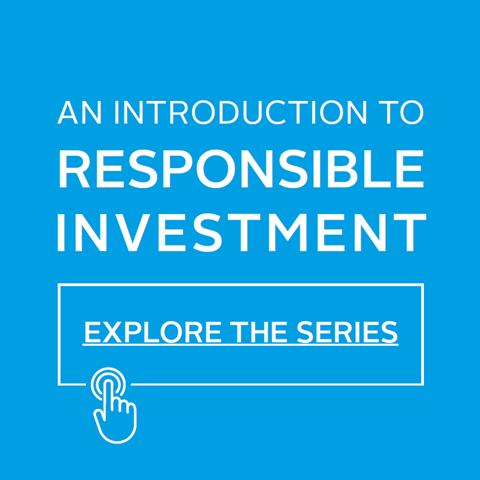Overview
- This starter guide provides a quick summary of approaches to responsible investment for direct and indirect real estate investors.
- It outlines options for including ESG issues in the investment process, management of assets and the relationship between asset owner and investment manager.
- Selected further reading is provided throughout.
Investing in real estate presents two key ESG considerations when compared with many other asset classes. Firstly, real estate is usually a long-term investment, allowing more time for material ESG issues to play out in ways that affect investors, the environment and society. Secondly, many ESG issues play out at a local level, for example extreme weather, water stress, legislative and/or regulatory requirements and community relations. Direct real estate investments are inextricably linked to a specific geographic location, making the incorporation of ESG issues particularly relevant. This guide will take you through the following steps to incorporate ESG factors in the real estate investment process:
| DIRECT INVESTORS | INDIRECT INVESTORS | |||||
|---|---|---|---|---|---|---|
| Deal sourcing | Investment decision | Ownership | Sale | Selection | Appointment | Monitoring |
Direct investors
DEAL SOURCING
Identifying material ESG issues during screening, due diligence and in the planning of new developments and major renovations
INVESTMENT DECISION
Communicating material issues to the investment committee and assessing their impact on valuation
OWNERSHIP
Including ESG issues in the management of the asset, use of external property managers and engagement with tenants
SALE
Adding value when the asset is sold
Deal sourcing
Screening
When an asset is first identified for potential acquisition, some simple checks can be made to see if there are any serious ESG issues that would rule out the deal immediately, e.g., financial risk related to regulatory fines or uncertain remediation costs related to contaminated land. Some investors also screen new deals for the presence of tenants tied to gambling or arms manufacture. Even at this preliminary stage in the deal process, it is best practice to signal to to the vendor that ESG issues are important to your firm.
Due diligence
Once a deal progresses to due diligence, ESG issues can be investigated more thoroughly. This stage includes assessing the potential for improvements, identifying legacy issues and analysing the impact of ESG factors, such as physical climate risks or energy efficiency standards. Before proceeding with a transaction, investors should consider how these factors – and the quality of relevant local infrastructure – might impact property valuations.
For investors that have set ESG targets, it is also important to assess the impact of the new asset. For example, if there is a target to reduce the portfolio’s energy consumption in line with Paris Agreement-aligned carbon reduction pathways, then understanding an inefficient building’s improvement options will be important.
In practice, ESG due diligence, whether carried out in-house or through the use of third-party consultants, typically starts with a standard list of factors that need to be considered for every deal.
Common ESG issues to investigate during due diligence:

ENVIRONMENTAL
- Biodiversity and habitat
- Climate change
- Land contamination
- Energy consumption
- Greenhouse gas emissions
- Indoor environmental quality
- Location and associated infrastructure
- Materials
- Pollution prevention
- Resilience to catastrophe/ disaster
- Renewable energy
- Sustainable procurement
- Waste management
- Water consumption

SOCIAL
- Community development
- Controversial tenants
- Health and well-being of occupants, contractors and the local community
- Human rights
- Accessibility
- Inclusion and diversity
- Labour standards and working conditions
- Social enterprise partnering
- Stakeholder relations
- Occupier amenities – showers, changing rooms

GOVERNANCE
- Anti-bribery and money laundering
- Cybersecurity
- Board diversity
- Independence of board members
- Remuneration policy (including ESG-linked incentives)
- Data protection and privacy
- Legal and regulatory fines
- ESG clauses in contracts
- Asset data collection framework and/or management systems
- Procurement standards and requirements
- Tenant engagement frameworks
Based on PRI Reporting Framework questions and GRESB assessment questions.
Due diligence outputs could include a commentary and/ or a risk rating and corresponding mitigation strategy for each issue. It is considered good practice to produce a list of improvements with costs and estimated savings.
The information required to assess each issue can come from a variety of sources, including:
- raw data – utility bills, building management systems, building logbooks, existing environmental management systems, engagement with tenants;
- third-party reports – energy audit reports, certification reports, surveyors’ reports, reports from other specialists and technical consultants;
- independent databases and vendors – geospatial databases, scenario analysis, flood records, green rating schemes.
New developments and major renovations
New construction or major renovations create opportunities to achieve higher ESG standards than may be possible through incremental work on operational assets. The ESG issues to consider are largely the same as with the management of operational buildings but some issues become more important, e.g., materials and supply chain (particularly CO2 emissions tied to production, known as embodied carbon), contractor health and safety and waste management.
To have maximum impact, ESG factors need to be included as early in the process as possible. During the design phase, the investor can request components that have better ESG performance, e.g., high-efficiency insulation. There is also more chance to add optional sustainability features, e.g., rainwater harvesting and renewable energy.
Investment decision
Investment committee
The investment memorandum should include any ESG risks, mitigation strategies, associated costs and assumptions identified during the due diligence process. This ensures due diligence outputs are incorporated into the decision-making process and understood by the investment committee. The memo should also note if no ESG risks were identified, highlighting that ESG factors were taken into account during due diligence. It is considered good practice for a member of the responsible investment team, or someone with responsibility for responsible investment, to have a seat on the investment committee to ensure that any outstanding issues can be addressed and that they have a say in the final investment decision.
Impact on valuation
Many ESG-related factors can lead to discounted valuations, as shown below.
|
ADDITIONAL CAPITAL EXPENDITURES |
Equipment upgrades to improve energy performance |
|
INCREASED COSTS |
Higher insurance premiums due to physical risk factors |
|
FUTURE INCOME UNCERTAINTY |
Tenant and leasing disruption due to extreme weatherevents |
|
OBSOLESCENCE RISK |
Buildings that do not meet minimum energy performancestandards set by legislation |
The impact of ESG factors on valuations should be considered throughout the investment process, not just when making an investment decision.
PRI and external resources:
- Sustainable real estate investment
- Positive impact real estate investment framework
- RICS guidance note: Sustainability and ESG in commercial property valuation and strategic advice
- TCFD for real assets investors
Ownership phase
Management of the asset
Examples of approaches to creating value through responsible investment:
Reducing costs and liabilities
- Operating costs – installing more energy-efficient equipment reduces costs.
- Liabilities – better knowledge of a building’s environmental condition reduces the chance of unforeseen litigation.
- Obsolescence – staying ahead of regulatory requirements reduces risk of falling foul of more stringent regulations.
Increasing revenue
- Fewer incentives – tenants prefer buildings with higher ESG performance, which reduces the need for incentives.
- Improved income – potential for higher rents and occupancy tied to increased demand for sustainable buildings with lower carbon footprints. [1]
- Sale of green energy – electricity generated on site (through solar panels or other means) can be sold on to tenants or local community.
- Demand shedding – buildings with flexible energy load profiles can alter their usage patterns to be eligible for rebates from utilities and government authorities.
Research conducted prior to acquisition gives investors a starting point for where to focus, but new issues will emerge during the holding period. It is important to have appropriate systems in place to manage issues on an ongoing basis. Some of the key processes to include:
- identifying ways to improve ESG performance – often accomplished by writing an action plan for each asset, which is reviewed and revised at set intervals;
- target setting – provide motivation and a way to measure success (typically about energy/water use, greenhouse gas emissions, waste management or tenant engagement);
- monitoring and reporting – a way to collect data on the asset’s ESG performance and report this to stakeholders.
The opportunity to report and disclose ESG performance attributes of individual assets, portfolios and institutions is increasing, with regulatory disclosure requirements also rising. Several reporting frameworks are widely used in the industry, such as the TCFD (the Task Force on Climate Related Financial Disclosures) and GRESB, a benchmark for ESG performance in real estate.
Certifications
Widely used in the real estate industry, a certification is an objective indicator of what constitutes a green building. It provides a signal that ESG has been considered in the building’s design and/or operation. The reports produced when the certification is granted contain useful due diligence information that can be used at each stage in the investment process. Certifications are also useful for attracting tenants and buyers.
Investors should ensure that the certification is not limited only to the design of a building but extends also to an assessment of its actual performance, ensuring both design and operational performance are certified by the relevant entities.
Asset-level certifications covering a broad range of ESG factors are in wide use. These include, but are not limited to:
- Leadership in Energy and Environmental Design (LEED)
- Building Research Establishment Environmental Assessment Method (BREEAM)
- the National Association of Home Builders (NAHBGreen) in the US
- the Comprehensive Assessment System for Built Environment Efficiency (CASBEE) in Japan
- the Singapore Building and Construction Authority’s Green Mark
- the Green Building Council of Australia’s Green Star rating.
- the International Finance Corporation Excellence in Design for Greater Efficiencies (EDGE)
Certain single-issue certifications are also available, such as WELL and Fitwel, focused on health and well-being, as well as an increasing number of net zero carbon buildings standards developed by individual country members of the World Green Building Council.
External property managers
As day-to-day management of the asset is often outsourced to an external property manager, the successful management of ESG issues will rest on selecting a good external property manager and understanding how to work with them effectively. This process can be broken down into three stages.
Selection – assessing the external property manager’s track record and expertise. This could include legislative compliance, ability to collect data, history of engaging tenants, ESG resourcing and internal training programmes and sustainable procurement practices. Some investors compile the assessment criteria into a score.
Appointment – the legal agreement between the external property manager and the investor. This could include a basic commitment to improving ESG performance or specific actions, such as energy use reduction targets. Some investors also make the bonus paid to the external property manager contingent on hitting ESG targets or performance levels.
Working with the external property manager – creating systems to check the external property manager’s performance and working with them to improve it. This could include:
- web-based portals to collect information – aggregate information can be used to benchmark different management companies
- annual scorecards
- site visits
- awards and recognition for outstanding performance
- sustainability committee
- manuals/guides on best practice
- training and workshops
Tenants
Engagement
Building a relationship with tenants is vital to managing ESG issues, as their behaviour affects areas such as energy use and recycling. Such engagement might be outsourced to an external property manager.
There are many actions that can be taken to engage with tenants:
- tenant handbook – a written guide that explains the importance of managing ESG issues and contains ideas for how to improve performance; regular meetings – schedule a regular meeting with tenants to discuss initiatives;
- sharing data – establish a system for tenants to provide their ESG data to the investor and for the investor to share data about the whole building;
- newsletters – send a newsletter to all tenants with the latest information on ESG initiatives;
- ESG committee – a formal or informal group which guides the direction of ESG work and has representatives drawn from various stakeholders;
- campaigns – one-off educational campaigns designed to change tenant behaviour;
- tenant satisfaction surveys – to identify issues that might relate to ESG performance and where improvements might be made;
- training - hold training workshops prior to tenants moving in on how to get the most out of the building and its sustainability features – usually for larger tenants.
Where the lease terms mean that the tenant has operational control and is responsible for insurance, repair, maintenance and other variable costs, investors can still play a role. They can offer to share knowledge and expertise, provide finance for projects and include the tenant in some of the items listed above.
ESG clauses in lease agreement
A lease for a property can, within its terms or through an attached schedule, include provisions that encourage the investor, tenant or both to carry out their roles in a sustainable way. The details of the provisions and the means of encouraging sustainable behaviour are negotiated between the parties, but typically relate to:
- commitments to cooperate and minimise negative, and maximise positive, ESG issues;
- responsibility for ESG performance and compliance with regulations (particularly where tenants have operational control), as well as capital expenditure on ESG projects and sharing of cost savings;
- sharing data and installation of energy and water submetering;
- commitment that ESG factors will be considered when using contractors, e.g., cleaners.
The use of ESG clauses in lease agreements varies widely according to geography and investor preferences. It is considered good practice to include ESG clauses in all lease agreements offered to tenants. An investor that wants ESG clauses will often give the legal team a set of guidelines on which ESG considerations could go into a lease.
PRI resources:
- Sustainable real estate investment
- Case study: M&G Investments – The journey to net zero
- Blog: Real estate powers ahead on decarbonisation
- EU Taxonomy alignment case study: CORESTATE
Sale
Managing ESG issues and improving performance during the ownership phase can reduce risk and enhance value, which can be realised on the asset’s sale. Other benefits that a responsible investment approach can yield on sale include:
- identifying and managing material ESG issues, which can prevent a buyer from raising unforeseen risks to negotiate a lower price;
- setting KPIs at the beginning of the holding period, and tracking these KPIs, which provides evidence to support claims that ESG issues are well managed;
- demonstrating a professional approach to managing ESG issues, signifying that the asset has been well managed.
Indirect investing
Investing in a fund
DEAL SOURCING
Investment manager -
showcasing responsible investment
approach in the fundraising/marketing
material
Asset owner -
conducting due diligence to assess the
quality of the investment manager
INVESTMENT DECISION
Embedding the most important responsible investment issues in the legal agreement between asset owner and investment manager
OWNERSHIP
Investment manager -
proactively reporting relevant
information to the asset owner
Asset owner -
monitoring that responsible investment
commitments are being put into
practice
When an investor chooses to invest in a fund managed by an external investment manager, a different approach to responsible investment is required. The investor cannot make, or materially influence, specific investment decisions, but it can still influence a decision-making process through fulfilment of its fiduciary duties and, where applicable, ESG policy. An indirect investor should monitor and, where necessary, engage an investment manager about the policies, systems and resources used to incorporate ESG factors into investment decisions, management and stewardship.
This can fall into the three main areas:
Selection
Investment managers can include references to responsible investment in the documentation used to advertise the fund and attract potential investors. This can be a starting point for asset owners to enquire about the investment manager’s responsible investment approach. Investors can also use a due diligence questionnaire to prompt dialogue, such as the PRI’s DDQ for real estate investors.
Appointment
Including responsible investment in the legal agreements and side letters reinforces the investment manager’s commitment to managing ESG issues and encourages the adoption of related business practices across the organisation.
Monitoring
Regular communication on responsible investment throughout the fund’s life cycle will help to strengthen the relationship, signal good management and manage reputational risks. This might include a mix of quantitative and qualitative information in client reports or in annual meetings. Approaches will differ depending on the fund structure (segregated portfolio or pooled vehicle).
PRI resources:
Downloads
An introduction to responsible investment: real estate
PDF, Size 0.88 mb責任投資の入門ガイドー不動産 (Japanese)
PDF, Size 1.07 mbIntroduction à l’investissement responsible : immobilier (French)
PDF, Size 1.04 mbIntroducción a la inversión responsable (Spanish)
PDF, Size 1.4 mb负责任投资简介:房地产 - 2022 update (Chinese)
PDF, Size 1.4 mb
References
[1] Feige, A., et al (2013) Rental price and sustainability ratings: which sustainability criteria are really paying back? p 322-334; Pommeranz, C., et al (2021) What Drives the Premium for Energy-Efficient Apartments – Green Awareness or Purchasing Power? p. 220–241; Leskinen, Niina, et al (2020). A Review of the Impact of Green Building Certification on the Cash Flows and Values of Commercial Properties.












